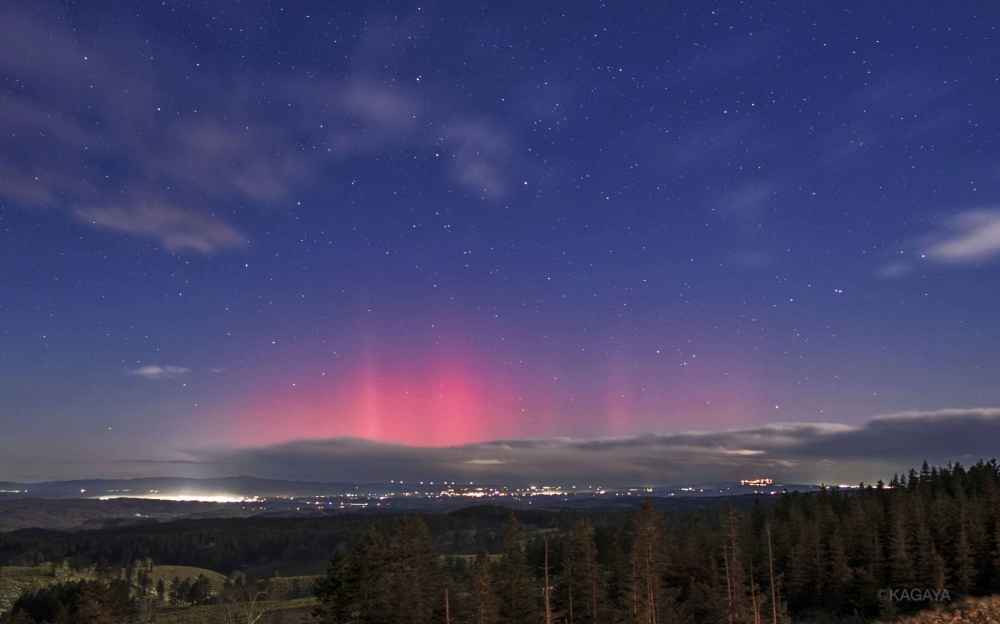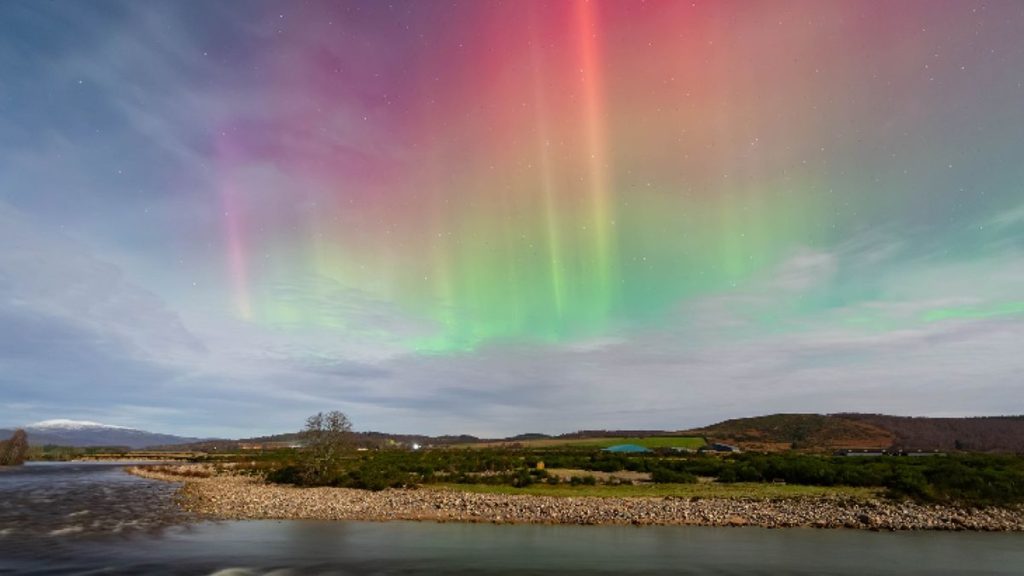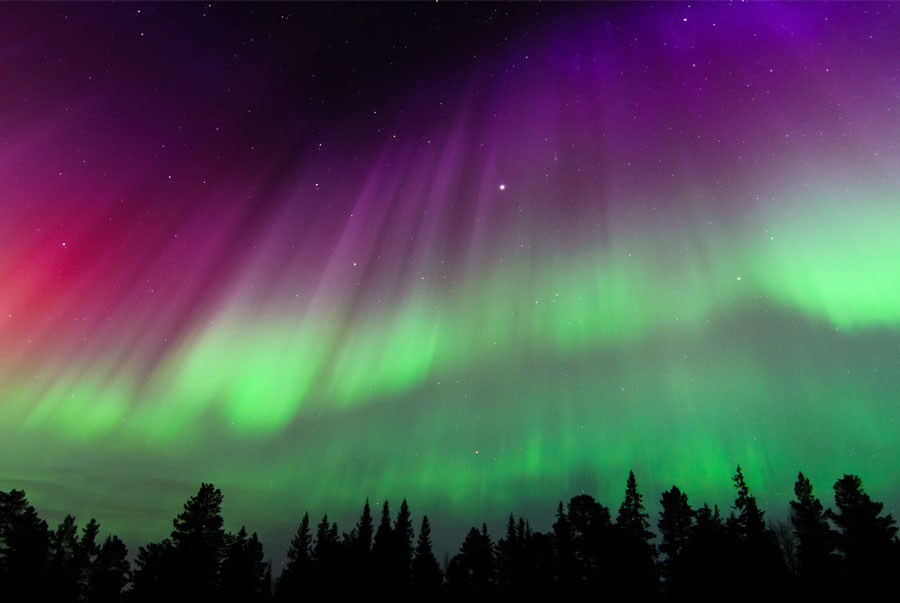Hi Readers!
When a solar storm (that I have been talking about in the last 2-3 blogs) comes toward the earth, some of its energy and small particles can penetrate the magnetic field at the North and South poles into Earth’s atmosphere. These particles then interact with gases in the atmosphere thereby displaying beautiful lights in the sky called aurora. Oxygen gives off green and red light.
A series of three geomagnetic storms caused such an auroral display (strongest for the 20 years) at the most Southerly latitudes in the Northern hemisphere on December 1st and 2nd, 2023. A red auroral display observed in Hokkaido, Japan was visible to the naked eye.
The aurora was apparently the result of a massive explosion that occurred on the sun’s surface about two days earlier when electrons from space collided with oxygen and nitrogen in the sky upon entering the earth’s magnetic field (please see Pictures below)

Aurora seen in Hokkaido, Japan and

Extremely rare orange aurora dancing in between reds and greens lights in the evening sky above Scotland during a geomagnetic storm on November 25th 2013. (Credit: Graeme Whippy).
Such auroras usually occur in the regions around the Arctic and the Antarctic but can also be observed in low-latitude areas such as Hokkaido, Japan.
The aurora began to be seen around 8:20 p.m. Friday from the observatory in the town of Rikubetsu, Hokkaido, Japan followed by the aurora’s red lights.
It is the first time since October 2003 that the brightness of a low-latitude aurora has been confirmed at this observatory and hence was considered the strongest of the 20 years. A 51-year-old staff member of the observatory says, “I could never imagine that I could see the red lights so clearly with the naked eye.”
According to The Japan Times, a red-colored aurora was seen with the naked eye from Hokkaido, the northernmost of Japan’s main islands, with the phenomenon visible to the naked eye for the first time since October 2003.
Scientist from Forbes innovation has been reporting since October 2023 that, Sun’s “solar maximum” will arrive early, peak higher, and last longer.
Please read the full article at the full article in the link below
The Space Weather Prediction Center (SWPC) says, “the sun is becoming more active more quickly than anticipated and will peak earlier than predicted. That peak will also last longer and could even peak twice, but probably, it will not break any previous records.
According to National Oceanic and Atmospheric Administration (NOAA), the prediction from the SWPC is its first for the current Solar Cycle 25 since December 2019, when it predicted that solar maximum (the most active point in the sun’s roughly 11-year cycle), would occur during 2025. It also indicated that Solar Cycle 25 would be weak.
According to SWPC, the new window for solar maximum is between January and October 2024. They derived this from the observations of sunspots, which are few rather meager and occasional but have been higher than expected during the last year.
The SWPC now predicted the maximum sunspot number between 137 and 173 in the month of the solar maximum but earlier in 2019, they predicted these numbers between 95 and 130 sunspots at a peak which is likely to occur between 2023 and 2026.
The scientist who is the solar cycle lead at SWPC says, “we expect that our new forecast will be much more accurate than the 2019’s panel prediction and, unlike previous solar cycle predictions, it will be continuously updated on a monthly basis as new sunspot observations become available,”
To remind you dear reader! I have been writing about sunspots and solar flares since April 2023 when I posted the first blog on this topic.
You can recall that sunspots are dark areas on the sun’s surface on either side of its equator and are caused by the changes in magnetic activity on the sun’s surface. A spike in sunspots tends to correlate with the sun being more active and emitting more radiation.
Predictions of when it will occur is crucial because a more active sun means more solar flares and coronal mass ejections, which affect Earth’s atmosphere and magnetic field
that causes not only intense aurorae but also increases danger to satellites, airline crews, astronauts and potentially increased solar storms mediated damage to electrical grids on Earth.
Yet a new prediction of SWPC about a highly active Solar Cycle 25 suggests that “the solar maximum will be between January and October 2024” while the sun’s peak activity will last longer than previously thought, the sunspot decline will take longer than the rise, and there’s a possibility of a double-peak at solar maximum when we can expect high solar activity and more frequent aurora sightings, until at least 2027.
It is quite possible that solar maximum could coincide with the next total solar eclipse which will be visible from within a 115 miles wide path of totality across North America on April 8, 2024.
The new prediction from SWPC comes after a serene October for the sun, which has dulled the excitement of a possible record-breaking solar cycle. “The Serenety of October comes after a period of unusually high solar activity earlier this year, which prompted some suggestions of a record-breaking solar cycle.”
NOAA’s new forecast suggests that this is unlikely, but there is always some degree of uncertainty in the model that could make a record high cycle possible (which although is questionable). However, looking over the past few centuries, the current solar cycle could be moderate, but higher than the low and slow cycle from NOAA’s previous forecast in 2019.”
That’s all for now dear readers.
Please never look at the sun with the naked eye or through binoculars or telescopes that are not fitted with solar filters.
See you next week. Take care, Bye.





